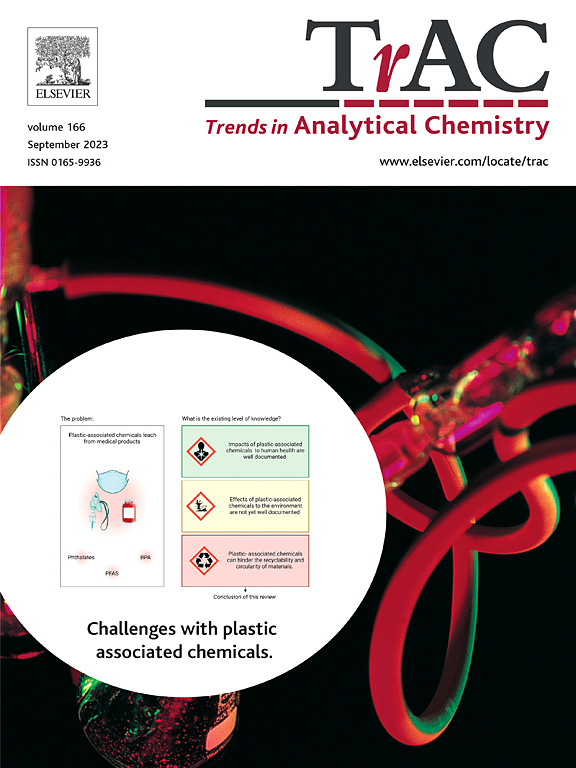从概念到应用:探索趋势和指导食品污染物分析小型化样品制备的发展
IF 12
1区 化学
Q1 CHEMISTRY, ANALYTICAL
引用次数: 0
摘要
在农业实践中过度使用化合物已使这些物质融入日常生活,引起人们对其对人类健康影响的严重关切。针对这些全球关注的问题,已经制定了许多分析策略来有效监测食品基质中的污染物,旨在检测和控制化学残留物,确保食品安全。鉴于此,基于固体和液体的小型化样品制备策略已被设计用于解决食品基质的复杂性,使痕量化合物的精确定性和定量分析成为可能。这些策略有效地去除干扰内源性化合物,同时预先浓缩目标分析物,确保在具有挑战性的食物基质中精确定量低污染物浓度。尽管它们在食品基质分析中得到了广泛的应用,但文献中缺乏对这些微萃取策略进行食品污染物分析的全面和最新的综述。此外,对使用小型化方法从食品样品中提取污染物的主要优势和挑战进行关键修订,为读者提供基于样品类型选择最合适方法的综合指南是必不可少的。因此,本文综述了食品基质中不同污染物的多用途固体和液体微型提取技术的最新应用和创新。本文章由计算机程序翻译,如有差异,请以英文原文为准。

From concept to application: Exploring trends and guiding developments in miniaturized sample preparation for food contaminant analysis
The excessive use of chemical compounds in agricultural practices has integrated these substances into daily life, raising significant concerns about their impact on human health. In response to these global concerns, numerous analytical strategies have been developed to monitor contaminants in food matrices effectively, aiming to detect and control chemical residues and ensure food safety. In light of this, solid and liquid-based miniaturized sample preparation strategies have been designed to address the complexities of food matrices, enabling accurate qualitative and quantitative analysis of trace-level compounds. These strategies effectively remove interfering endogenous compounds while simultaneously preconcentrating target analytes, ensuring the precise quantification of low contaminant concentrations in challenging food matrices. Despite their extensive applications in food matrix analysis, the literature lacks comprehensive and up-to-date reviews on these microextraction strategies for contaminant analysis in food. Moreover, a critical revision of the main advantages and challenges associated with extracting contaminants from food samples using miniaturized approaches is essential to provide readers with a comprehensive guide for selecting the most suitable method based on the sample type. Hence, this review study brings to light recent applications and innovations regarding versatile solid and liquid-based miniaturized extraction of different contaminants in food matrices.
求助全文
通过发布文献求助,成功后即可免费获取论文全文。
去求助
来源期刊

Trends in Analytical Chemistry
化学-分析化学
CiteScore
20.00
自引率
4.60%
发文量
257
审稿时长
3.4 months
期刊介绍:
TrAC publishes succinct and critical overviews of recent advancements in analytical chemistry, designed to assist analytical chemists and other users of analytical techniques. These reviews offer excellent, up-to-date, and timely coverage of various topics within analytical chemistry. Encompassing areas such as analytical instrumentation, biomedical analysis, biomolecular analysis, biosensors, chemical analysis, chemometrics, clinical chemistry, drug discovery, environmental analysis and monitoring, food analysis, forensic science, laboratory automation, materials science, metabolomics, pesticide-residue analysis, pharmaceutical analysis, proteomics, surface science, and water analysis and monitoring, these critical reviews provide comprehensive insights for practitioners in the field.
 求助内容:
求助内容: 应助结果提醒方式:
应助结果提醒方式:


